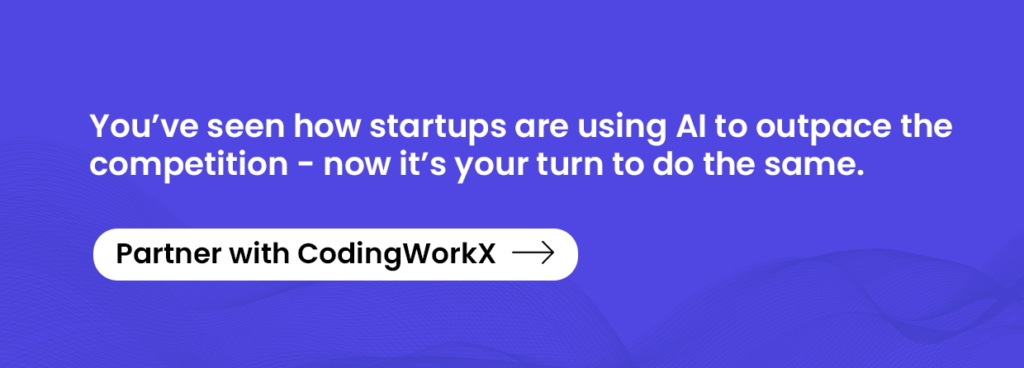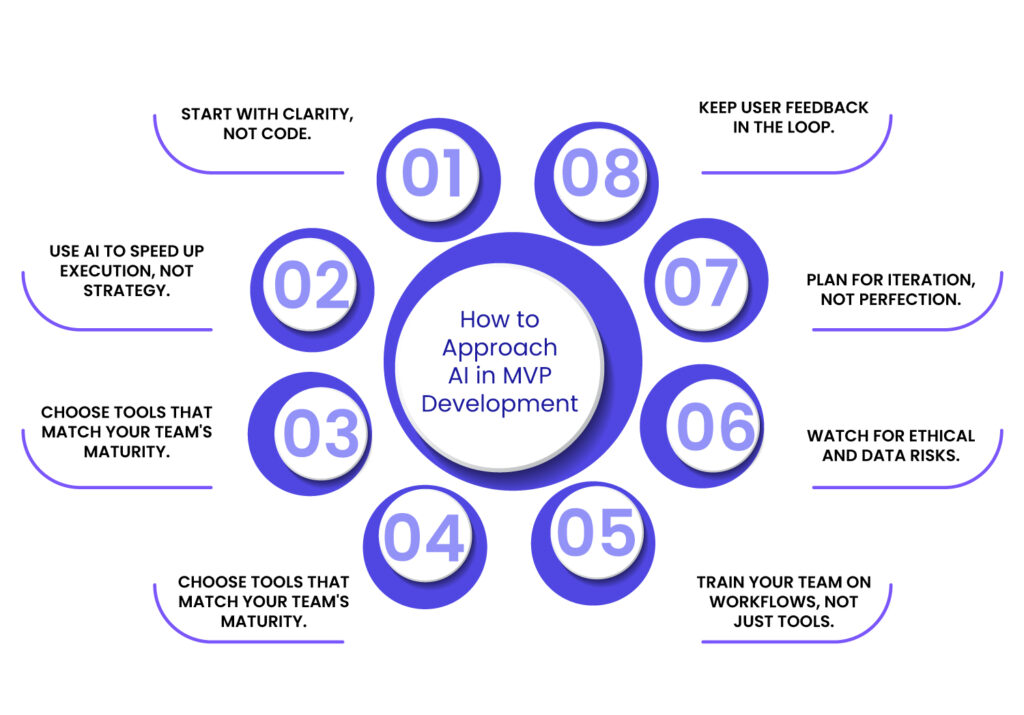
In today’s startup landscape, the difference between getting to market first and being forgotten isn’t always innovation – it’s execution. The Minimum Viable Product (MVP) was born out of this urgency, helping teams test bold ideas with minimal waste. But as competition stiffens and user expectations rise, even MVPs are expected to deliver more – faster.
Enter artificial intelligence.
AI isn’t just a buzzword thrown into pitch decks or press releases. When applied thoughtfully, it becomes a force multiplier for MVP development – compressing timelines, reducing costs, sharpening decision-making, and giving you validated insights before a single line of code is written.
This article explores how AI in MVP development is transforming the software playbook – from ideation to iteration – and why startups that integrate AI early are pulling ahead, while others are left iterating in the dark.
Why AI is Becoming Non-Negotiable in MVP Development
Building an MVP used to be about moving fast and breaking things. But today, you need to move fast and get it mostly right the first time. Users don’t have patience for broken flows. Investors want traction, not just prototypes. And the market shifts while you’re still validating assumptions. The benefits of using AI for mvp helps you keep up – and even stay ahead.
Here’s how:
1. Faster Time to Market
AI streamlines repetitive tasks like user research, data analysis, and even frontend/backend code generation. What once took weeks now takes days. This compression gives teams a crucial edge in capturing early adopters before competitors catch on.
2. Data-Driven Decisions from Day One
You don’t have to guess what users want. AI tools can analyze public data, social chatter, or app usage patterns to validate demand, identify feature gaps, and shape roadmaps based on actual behavior – not assumptions.
3. Lean Teams, Big Impact
With AI automating tasks like UX copywriting, wireframing, or user feedback classification, lean teams can punch far above their weight. A two-person startup can build and test like a team of ten.
4. Continuous Learning and Iteration
MVPs aren’t meant to be perfect – they’re meant to evolve. AI solutions in MVP development when integrated into product analytics or A/B testing engines can identify user friction, predict churn, and suggest improvements in real time. You learn faster, pivot smarter, and waste less.
5. Personalized User Experiences – Early On
The answer to why use AI in MVP design process often lies in how AI enables tailored onboarding, recommendation engines, or chatbot flows from the MVP stage itself – giving users a sense of polish and relevance that used to come much later in the product life cycle.

How AI Is Being Used in MVP Development?
AI in MVP development isn’t just a productivity booster – it’s reshaping how startups build, test, and scale MVPs. Across the development lifecycle, it enhances speed, reduces guesswork, and empowers lean teams to launch with confidence. Here’s how AI is being actively embedded at every stage.
1. AI for Faster, Smarter Ideation
Traditionally, founders would spend weeks running surveys, analyzing competitor apps, or scrolling through Reddit threads to validate their idea. Now, AI for product development tools can aggregate and analyze massive volumes of user-generated content in minutes. For instance, natural language processing models can mine thousands of app reviews or social conversations to identify pain points and unmet needs. One mental health startup used GPT-based tools to analyze discussions on therapy platforms and discovered a recurring frustration: users wanted journaling features that adapted to mood. This insight – surfaced in hours – directly shaped the startup’s MVP offering, saving them weeks of manual research and false starts.
2. AI-Accelerated Prototyping and UX Design
Designing interfaces has never been faster. AI-powered tools like Uizard and Galileo can convert text prompts or basic sketches into functioning wireframes – a major advantage when teams need to iterate on multiple UI ideas without burning design resources. Startups are also using AI in product design to generate UX copy, onboarding instructions, and micro-interactions that feel polished right from version one. In one case, a solo founder building a travel MVP was able to present three high-fidelity UI variations to test groups within a single weekend, all thanks to AI handling design generation and copywriting. That level of speed and flexibility would’ve been near-impossible even a few years ago.
3. AI-Assisted Development
On the engineering side, AI for product development is quietly transforming the way code is written. GitHub Copilot and Tabnine are being used as co-developers, writing boilerplate code, suggesting entire functions, and helping devs spot bugs in real time. Especially for MVPs where technical debt isn’t yet a blocker, this kind of assistance can shave off weeks of dev time. One SaaS founder reported that their two-person team completed a functional MVP app development process in just 12 days – something that would’ve taken over a month before. AI also helps suggest relevant APIs, autofill repetitive tasks, and improve code consistency, making it a powerful asset for lean teams under pressure.
4. AI in User Testing and Feedback Analysis
Once the MVP is in users’ hands, the benefits of using AI for mvp continues to add value by simplifying the feedback loop. Startups no longer need to manually comb through survey responses or bug reports – AI-driven tools like MonkeyLearn or Thematic automatically categorize input, highlight sentiment patterns, and surface friction points. One productivity app team used AI to process 800+ beta feedback entries and discovered that most user frustration stemmed from a poorly explained onboarding feature. This insight enabled them to make a single tweak that increased activation by 22% – a quick win they might have missed using traditional methods.
5. AI for Smarter MVP Iteration
Post-launch, AI solutions in MVP development helps teams move from reactive to proactive iteration. Instead of waiting for user drop-off to happen, AI-enhanced analytics platforms track behavior patterns and predict churn before it hits. Startups can run smarter A/B tests, optimize onboarding flows, and personalize user experiences even in their earliest product versions. A streaming MVP used AI to analyze viewing data and discovered that users were more engaged when shown content teasers after 20 seconds of inactivity. By adapting their UX in real time, they reduced bounce rates and boosted retention – all before their Series A.

Why AI Makes Business Sense for MVP Development
Building an MVP has always been a game of speed versus resources. Founders juggle timelines, talent shortages, and tight budgets while racing to test a product that might not yet have market fit. This is exactly where the benefits of using AI for mvp makes a measurable difference – not just in what gets built, but how efficiently it’s built.
AI reduces reliance on large, expensive teams by filling in the gaps – whether that’s generating frontend code, handling UX writing, or auto-sorting user feedback. A design sprint that once needed a full UI/UX team can now be executed with one designer and an AI wireframing tool. Development tasks that consumed hours of debugging or documentation can be offloaded to code copilots. These tools don’t replace people – they make small teams feel much bigger.
In financial terms, this means founders can achieve more with less. An MVP that might have taken $100,000 to develop through traditional outsourcing can now be prototyped, tested, and launched at a fraction of that cost. AI brings down labor costs, shortens time-to-market, and frees up human talent to focus on strategic decisions – not repetitive work.
More importantly, AI for product development reduces the cost of being wrong. If a product direction isn’t working, AI helps you pivot faster – by running new iterations, scanning fresh feedback, or analyzing market shifts in real time. That level of responsiveness can mean the difference between burning cash and finding product-market fit before your runway runs out.
| Category | Traditional MVP Development | AI-Assisted MVP Development |
| Time to Market | 12–16 weeks | 4–8 weeks |
| Average Development Cost | $80,000 – $150,000 | $30,000 – $70,000 |
| Team Size Needed | 6–8 (PM, designer, devs, QA, analyst) | 2–4 (with AI tools handling design/dev/UX tasks) |
| Prototyping Time | 2–3 weeks | 1–2 days (AI-powered prototyping tools) |
| Frontend & UX Design | Manual design, mockups | AI-generated wireframes and UI components |
| Code Generation | 100% manual coding | Up to 40–60% assisted by AI (e.g., Copilot) |
| User Feedback Analysis | Manual tagging, clustering, sentiment mapping | Automated insights from tools like MonkeyLearn |
| Iteration Speed | Slower – dependent on sprint cycles | Near real-time – thanks to AI-enhanced workflows |
| Error/Bug Detection | Manual QA testing | AI-assisted code reviews & automated QA |
| Cost of Early Pivot | High – sunk dev/design cost | Low – AI speeds up rework and revalidation |
Challenges of Using AI in MVP Development
While AI brings speed, savings, and scalability, it’s not without its own set of challenges. Founders exploring AI-driven MVP app development need to be aware of the nuances – because smart tech still requires smart decisions.
One of the most common misconceptions is that AI tools can replace foundational thinking. Tools like GitHub Copilot or Uizard can certainly accelerate execution, but they won’t define your core value proposition, understand your target user at a strategic level, or tell you what to build. Founders still need to lead with clarity and purpose – AI can only amplify a good idea, not rescue a vague one.
Then there’s the issue of quality. AI in product design or code may look functional on the surface, but often lack the nuanced polish that comes from human review. Over-reliance on AI without QA checks can lead to brittle MVPs that crack under real-world usage. For example, auto-generated UI might not account for accessibility, and AI-written backend logic could carry security flaws if not vetted carefully.
Privacy and data security present another layer of concern. Many AI tools process data in the cloud, raising flags for startups building in regulated industries like healthcare or finance. Early-stage teams must balance the convenience of AI with the legal implications of how user or proprietary data is handled during development.
Finally, there’s the learning curve. While most tools are user-friendly, not every founder or team member will be instantly productive with them. Getting value out of AI sometimes requires trial-and-error, experimentation, and even changes to team workflows. Integrating AI too late into a tightly packed MVP timeline can create friction rather than efficiency.
The good news? These are manageable challenges. The more intentional teams are with when and how they use AI, the more they can mitigate risks – and build faster, smarter MVPs that stand up to both user scrutiny and business goals.
How to Approach AI in MVP Development Without Falling into the Traps

- Start with clarity, not code.
Before introducing any AI tools, define the problem you’re solving, who you’re solving it for, and what a successful MVP looks like. AI won’t help if your product vision is still fuzzy. - Use AI to speed up execution, not strategy.
Let AI assist in wireframing, prototyping, and code generation – but keep critical thinking, design decisions, and UX strategy human-led. Founders should still guide the “why” and “what” of the product. - Choose tools that match your team’s maturity.
Go for tools that fit your current skill level and tech stack. For example, low-code platforms like Bubble or AI prototyping tools like Uizard are great for non-technical founders, while dev teams may benefit more from GitHub Copilot or Replit’s Ghostwriter. - Validate AI-generated outputs.
Always review, refine, and test what AI produces – be it code, content, or design. Don’t treat its outputs as final. Think of AI as a fast intern: helpful, but always needing supervision. - Keep user feedback in the loop.
Use AI to analyze feedback at scale, but let real user interactions shape product direction. Automated insights should inform your roadmap, not dictate it. - Plan for iteration, not perfection.
MVPs aren’t about building the best version – they’re about building fast and learning fast. AI helps you get there quicker, but you should still expect to revise, pivot, and evolve based on what you learn. - Watch for ethical and data risks.
Be mindful of how AI tools handle your data, especially in industries with compliance requirements. If you’re feeding user data into any AI system, make sure it’s anonymized, secure, and compliant. - Train your team on workflows, not just tools.
Getting value from AI requires a shift in how your team works – not just which tools they use. Help them think in terms of rapid experimentation, validation loops, and creative delegation to AI.
How We Do AI-Led MVP Development at Codingworkx
At Codingworkx, we don’t treat AI as an add-on – it’s built into how we approach MVPs from day zero. Our process blends proven product thinking with AI-enhanced workflows to help founders build faster, cheaper, and with more certainty.
We begin by working closely with you to define the why behind your product – your users, goals, and market. Once we’ve nailed the strategy, we bring in the right mix of AI tools to accelerate execution without compromising quality. Think AI-generated wireframes, AI-assisted code scaffolding, or automated testing suites – all under expert supervision.
Our design teams use reliable AI in product design tools like Uizard, Galileo, and Framer to go from idea to interactive prototype in days – not weeks. For development, we rely on copilots and low-code integrations to reduce boilerplate effort, freeing up engineers to focus on core logic and edge cases. And when it comes to feedback loops, we plug in AI-driven analytics to understand how real users engage with your MVP – so we can iterate with purpose.
But what makes our process different isn’t just the tech – it’s how we wrap it with product guidance. You’ll never get “just a toolchain.” You’ll get a product partner who knows when to move fast, when to slow down, and how to use AI to make better decisions at every turn.
So whether you’re building your first MVP or rethinking your approach to product validation, we bring the best of AI and human expertise to get you from zero to market – faster and smarter.
FAQs.
Q. How can AI improve the MVP development process?
Ans. AI accelerates MVP development by automating repetitive tasks like code generation, bug detection, and UI suggestions. It can also enhance decision-making through data-driven insights, ensuring early-stage products are aligned with user demand and market trends.
Q. What are the benefits of using AI for MVP development?
Ans. Using AI in MVP development reduces time-to-market, lowers costs, and improves accuracy. It helps predict user preferences, generate mockups or content, and even prioritize features, allowing teams to focus on strategy rather than execution overhead.
Q. Which AI tools are best for building MVPs faster?
Ans. Popular AI tools include GitHub Copilot for coding, Figma AI for design automation, ChatGPT or Claude for content and ideation, and tools like Builder.ai or Uizard for low-code/no-code app development. Each helps speed up different stages of MVP creation.
Q. Is AI useful for validating MVP ideas quickly?
Ans. Yes, AI can analyze market trends, user behavior, and competitor data to validate MVP concepts faster. Tools like GPT-based assistants or AI analytics platforms can simulate user feedback or forecast demand based on existing datasets.
Q. Can AI reduce the cost of MVP development?
Ans. Absolutely. AI reduces the need for large teams and manual work by automating testing, prototyping, and user research. This streamlines operations, cutting down both time and resource costs significantly in the early product stages.
Q. How does AI help in faster product-market fit?
Ans. AI tools analyze user feedback, market signals, and product usage data in real-time. This enables teams to iterate faster, pivot when needed, and double down on features that resonate – leading to quicker alignment with market expectations.
Q. What role does AI play in user feedback analysis for MVPs?
Ans. AI-powered sentiment analysis and NLP tools can sift through reviews, support tickets, and user interactions to uncover pain points and patterns. This ensures feedback is not just collected but also transformed into actionable insights rapidly.
Q. Is AI suitable for startups building their first MVP?
Ans. Yes, startups benefit the most. AI helps small teams do more with less, be it brainstorming features, building prototypes, or validating ideas. It’s especially useful when speed and adaptability are crucial but resources are limited.
Q. How secure is an AI-powered MVP development process?
Ans. Security depends on the tools and infrastructure used. Reputable AI platforms offer robust encryption, compliance with global standards (like GDPR), and sandboxed environments. When guided by experienced developers, AI-powered MVPs can be just as secure as traditional builds.
Q. Why choose CodingWorkX for AI-driven MVP development?
Ans. CodingWorkX combines technical expertise with AI innovation to build smarter MVPs – faster. From ideation and design to development and validation, we integrate AI at every step to reduce risk, speed up delivery, and ensure your product gets to market with impact.
